
How to Clean Beer Glasses
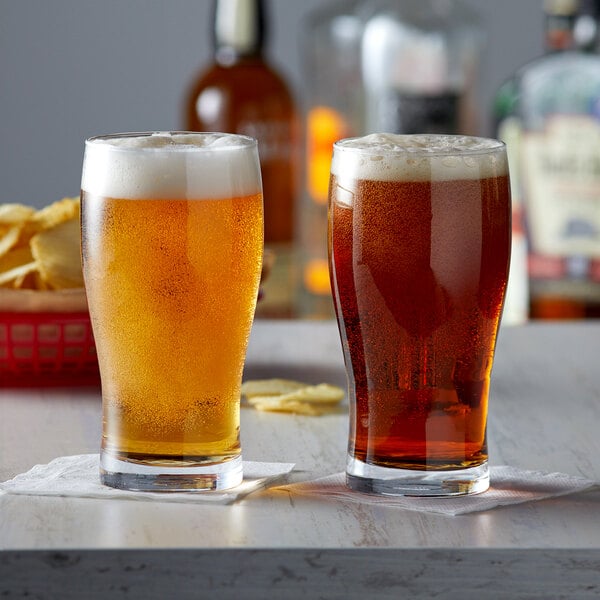
The Importance of Cleaning Your Beer Glasses
Pouring a perfect beer doesn't start with your draft. It starts with a clean glass. If the glass is dirty, it can make your beer go flat quickly and lose its distinct aroma. Plus, it inhibits you from having a 1/2" to 1" thick head on top, ultimately wasting product.
To achieve the perfect pour, your glass needs to be "beer clean." This industry term means that it's clean from impurities that give C02 a place to cling to. Once the spots are removed, the beer can pour better for its best look and taste.
A standard half barrel keg with 15.5 gallons of beer should yield approximately:
- (124) 16 oz. glasses
- (142) 14 oz. glasses
However, with a proper cleaner and washing system, you'd only need to pour 14 oz. into a 16 oz. glass because of how the product head is forming. This could give you up to 18 more glasses per keg. If you're not seeing results like this in your bar, it may be time to take a look at your cleaning process.
How Can You Tell if a Beer Glass is Clean?
To check how well you're cleaning your beer glasses, try doing one of these three tests on your glassware:
Sheeting Test
- Dip the glass in water
- Check to see how it coats
- If it coats the glass evenly, it's clean
- If it breaks into droplets, it's dirty
Salt Test
- Sprinkle salt inside a wet glass
- Check to see how it coats
- If it coats the glass evenly, it's clean
- If it doesn't stick on spots, the glass is dirty
Lacing Test
- Fill a glass with beer
- Pour a bit out to let foam settle
- If it creates parallel rings, it's clean
- If it has a random pattern or no pattern, it's dirty
How to Clean Beer Glasses Properly
- Avoid using the glass for other beverages like milk, soda, or juice
- Do not dry the glass with a regular towel
- Take care to not store the glass near grease, dust, or heavy odors
The benefits of portion packs include:
- No need to measure behind the bar on a busy night
- Less waste due to over-mixing - many over-measure when diluting cleaning chemicals
- Less chance of under-mixing - especially important when it comes to sanitizer
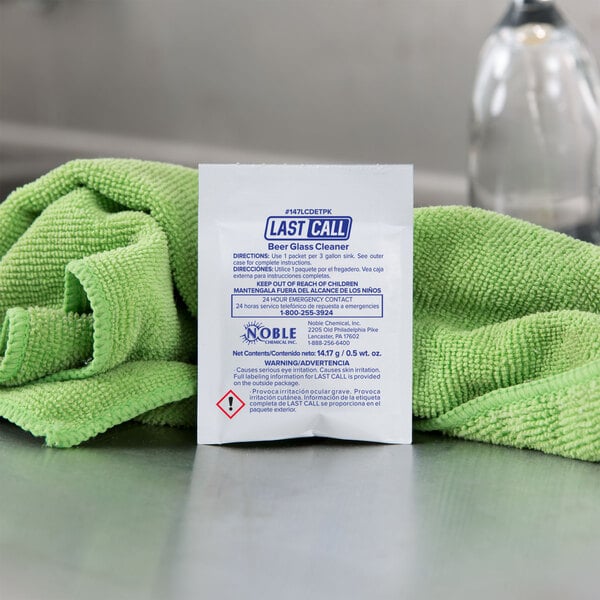
1. Pick a Detergent
Bar glass detergent is specifically made for quick and easy cleaning thanks to its concentrated formulation. It can remove stains (like lipstick) with ease, but also get rid of other less visible stains such as grease-based residue.
Regular glass cleaner should only be used with manual glass washing brushes for best results. Plus, this detergent is specially made to rinse completely and leave your glass crystal clear and free of any soap residue.
If you're going to use an electric glass washing brush, be sure to pick a low suds cleaner. It offers the same benefits as regular bar glass detergent, but the low sudsing formula is more friendly for use with an electric brush system.

2. Choose an Effective Sanitizer
It's important in any warewashing system to use a good sanitizer after washing and rinsing your items, so you can rid them of bacteria that cause infections. For proper sanitizing, be sure to use water heated to at least 75 degrees Fahrenheit. When used properly, your sanitizer can also meet the Federal sanitation guidelines so your kitchen is compliant.
If you're worried about appearance, the Noble Chemical Last Call liquid sanitizer packet is a great option. Its special formula makes glassware shine while sanitizing your glassware to rid it of any dangerous bacteria.
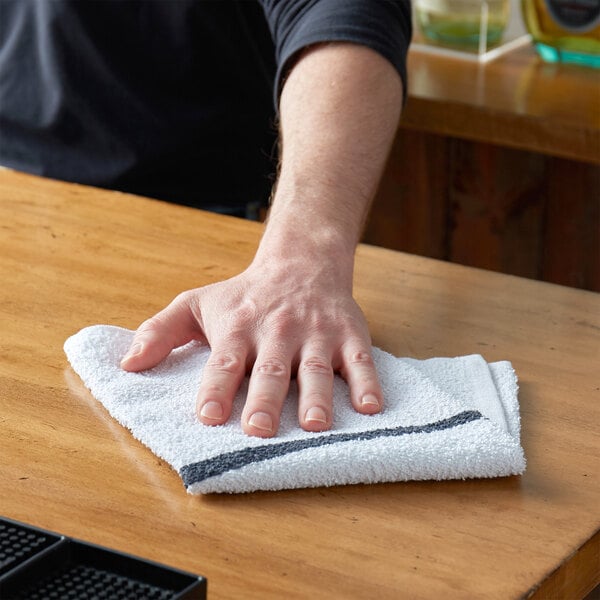
3. Properly Dry Glassware
The best way to keep your glassware clean while drying is to always air dry it. Using a towel can leave lint, odors, and germs on the glass. However if you need to speed up the drying process, you can use a microfiber towel to get the job done and keep your glass clean.
Just make sure you always dry glassware thoroughly so that no mildew is able to grow. Also consider storing your glassware in a spot that has good air circulation and is away from odors, dust, grease, or smoke.
Steps for Cleaning a Beer Glass
Once you've selected the chemicals you want to use, it's time to create your warewashing system. You should follow directions on your cleaning chemicals for mixing it, however below is a guideline of what your process should look like for a clean beer glass.
- Start with a clean stainless steel sink. Use a little bit of bar glass cleaner and a clean brush.
- Fill the bowl with hot water almost to the top of the brushes. Add mineral solvents to prevent hard water spots while the glass dries.
- Measure the proper amount of glass cleaner mentioned on your packet and add it to the first sink, sprinkling over the brushes.
- Fill the second bowl with clean hot running water to rinse the detergent off glassware coming from the first bowl.
- Fill the third bowl with about 3 gallons of hot water. Add the proper amount of sanitizer and test that it's the proper concentration.
- Wash the glass in the first sink, making sure all parts of it come in contact with the brushes. If using a 3-brush manual system, clean with the center brush.
- Rinse glass in the second bowl placing the bottom of it in at an angle and then withdrawing at an angle to prevent air from forming, for a thorough rinse.
- Repeat this process in the third bowl, dipping the glass into your sanitizing solution. Follow any local and/or national sanitation guidelines for proper sanitizing.
- Air dry the sanitized glass upside down, on a corrugated drain board to allow for maximum airflow around the glass and optimal results.
Related Resources
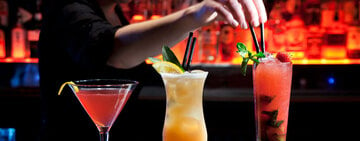
Bartending School Vs. Experience
For any bar owner, the difference between success and failure often depends on the skill of their bartenders. Having well-trained, professional bartenders on your staff is essential for any kind of establishment from your local dive bar to an upscale lounge. But when it comes to experienced professionals, what's the best way to become a great bartender? Read on to learn the pros and cons of bartending school versus bartending experience. Bartending School Generally speaking, most bar managers won't hire a bartender straight out of school. But, having a certificate from a reputable institution shows that you're serious about this career, and it can prove that you have a basic understanding of mixology. You will most likely still be starting
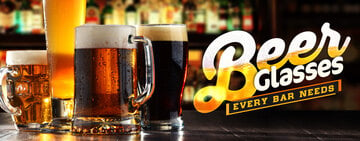
Beer Glass Buying Guide
Whether you own a taphouse or brewery , using the right glassware to serve your beers will highlight the characteristics that make each style unique. Color, carbonation, and aromatics can all be enhanced by the shape and thickness of the glass. Using the appropriate glassware for each type of beer has the potential to improve the craft beer experience for your guests. Keep reading to learn all about the beer glass types available and which beers they complement the most. Shop All Beer Glasses Click below to learn more about each type of beer glass: American Pint Glass Imperial Pint Glass Pilsner Glass Weizen Glass Snifter Glass Tulip Glass Beer Goblet IPA Glass Stout Glass Stange Glass Dimple Beer Mug Beer Boot Types of Beer Glasses Chart
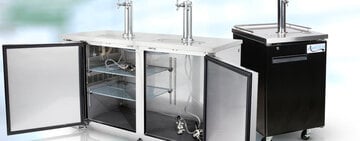
Beer Dispenser Installation and Maintenance
Designed to quench the thirst of dozens of customers, beer dispensers are excellent additions to restaurants, bars, catered events, and more. Their simple design makes them easy to use, and they have the capacity to serve dozens before needing a refill. Just like any other type of equipment, these systems require routine maintenance . In this guide, learn how to select the right dispenser for you, how to set it up, and find recommendations for upkeep and cleaning. Shop All
- Topics 1343
- Industrial 55
- Troubleshooting Guides 21
- Restaurant Management 128
- Bar Management 55
- Catering Tips 35
- Bakery Management 41
- Food Trucks & Concessions 49
- Advertising & Marketing 37
- Eco-Friendly Tips 11
- Facility Layout & Design 41
- Coffee Shop Tips 27
- Installation & Maintenance 51
- Janitorial & Pest Control 30
- Safety & Sanitation 88
- Startup Tips 104
- Menu Design 10
- Kitchen & Cooking Tips 81
- Hospitality Management 23
- Pizza & Sandwich Shop Tips 35
- Smallwares 37
- Food Prep 88
- Tabletop Items 17
- Disposables 22
- Calculators & Tools 6
- Consumables 52
- Warewashing & Laundry 18
- Cooking Equipment 90
- Food Storage & Refrigeration 51
- Beverage Equipment 34
- Office Supplies 6
- Resource Type
- In-Depth Articles271
- Buying Guides296
- How-Tos93
- Product Reviews77


